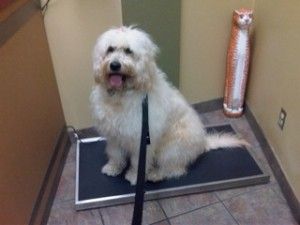By Dr. Patrick Mahaney, VMD
 Dr. Mahaney and one of his many special patients!
Dr. Mahaney and one of his many special patients!
Choosing the right veterinarian for your pet is a relationship-building experience akin to finding a pediatrician to take care of your child's health needs. It is truly a human-to-human connection (care provider to client) that extends beyond the exam room table and into your pet’s daily life. Working with a vet who understands your canine or feline companion's body, both inside and out, is the best way to prevent and manage diseases. Being able to trust your vet also means you’ll be better able to understand and follow healthcare recommendations. Establishing this relationship early in your pet’s life is an important step in providing the most appropriate healthcare on a long-term basis. Here’s how you can find the right veterinarian for you and your pet.
Do an Online Search for Veterinarians in Your Area Searching can certainly bring up a lot of information about the veterinary hospitals and individual doctors in your area. I believe that real-life impressions and personal referrals will give you a better idea of the kind of vet you’re getting. From the list of nearby vets you find online, I recommend going to one personally to determine the best one for you and your pet. Some experienced or “old school” vet clinics might not see the need for a webpage, considering they’ve had a steady stream of clients and patients for decades. But as we live in the electronic age, I suggest choosing veterinarians that have a professional, useful, practice-specific webpage.
Ask for a Referral to a Local Veterinarian Although you can search online and find general practice and emergency/specialty hospitals near your home and perhaps even read their reviews on sites like Yelp, it’s really best that you formulate your own opinions of a veterinary hospital or doctor through recommendations from a trusted human resource and your first-hand experience. When seeking such a referral from a friend, family member or coworker, make sure to ask:
1. How long has the veterinarian overseen the care of their pet?
2. Was veterinary care provided during illness, wellness or both?
3. What are the veterinarian’s strengths and weaknesses?
4. How available is the veterinarian for communication and appointments?
Schedule a “Get to Know You” Wellness Appointment Scheduling a wellness appointment at a time when your pet is otherwise healthy is a great way to get to know your new veterinarian, hospital facility and staff. At this first meeting, observe the veterinarian's interaction with your pet. The veterinarian should approach your pet in a friendly manner to minimize stress and promote positive interaction. Ask that the veterinarian perform the physical exam in your presence to provide maximum transparency on pet-handling techniques (i.e. head-to-tail-to-toe examination). You should feel comfortable explaining your pet’s medical history and asking questions, and the vet should listen patiently and explain any abnormalities found in the physical exam. You can also ask these additional questions:
1. How many vets are in your practice? Will I see the same vet every time?
2. What are the qualifications of the technical staff? What do I need to see the vet for, and what can the vet techs handle?
3. Do you offer after-hours care? If not, can you recommend an emergency clinic?
4. How many days in advance should I schedule appointments?
5. What kinds of veterinary medicine, e.g., surgery, medicine, etc., do you find the most interesting?
6. Do you have any additional certifications?
Find Out How to Best Communicate with Your Veterinarian All veterinarians are different in their practice style, with some very much enjoying or advocating client communication, and others only offering their time during an in-facility appointment. My practice style is open to client communication, with email being the primary means by which my clients and I correspond between appointments. Other practitioners may prefer the phone approach, but I spend so much time driving to my clients’ homes and giving them real-life face time that phone calls are less preferred. Although communication with your veterinarian via social media is also a growing trend, social media should not be used to discuss the medical aspects of your pet’s case. All conversation, regardless of format, should end up as part of a pet’s medical record. So, before you send an elaborate email or float a question via Facebook, find out what communication format will get your veterinarian’s most timely and thorough response.
Referrals to Other Veterinarians Although we veterinarians are trained in a variety of species and types of medical problems affecting our patients, there often are limits to the medical and surgical treatments that we have experience providing. If a pet’s particular ailments supersede our abilities to diagnose and prescribe treatment, then a referral to a more seasoned practitioner is in the best interest of the patient. For example, if a dog ruptures her cranial cruciate ligament and needs an orthopedic procedure, this is usually done best by a board-certified veterinary surgeon who frequently performs this procedure. Or if a cat is diagnosed with cancer, a veterinary oncologist can best describe treatment options.
 The exam room, scale and reception area should all be properly cleaned and presentable.
The exam room, scale and reception area should all be properly cleaned and presentable.
Red Flags When it comes down to it, there are many potential red flags that you need to consider in establishing and maintaining a long-term professional relationship with your veterinarian. Not every red flag necessarily means you should find a new care provider, but make note of instances where your or your pet’s needs were not best served.
1. Poor hygiene. The cleanliness of the office space and the veterinary professional’s personal appearance speaks volumes as to basic values of practice. Laboratory coats, scrubs and other clothing should be well-maintained and clean. Hands, scales and exam tables should always be washed between patients. Lack of cleanliness is unprofessional, unsafe and should send up major red flags.
2. Substandard communication. A veterinarian that does not look you in the eye while engaging in conversation, won’t interact with your pet with any degree of interest or is unwilling to communicate with you in a reasonable manner to ensure you fully understand your pet's case is a major red flag.
3. Support staff impressions. If the front desk staff and technicians don’t enjoy working with or won’t permit a particular veterinarian to treat their own pets, then red flags should go up.
4. Refusal to refer. If your veterinarian is unwilling to refer you to a specialist and chooses to exclusively treat a difficult case himself, then your pet’s best interests may not be met. Once again, red flag! Ultimately, any concerns you may have pertaining to the care provided by your veterinarian or veterinary hospital should be directly taken up with the veterinarian or hospital’s administrative official.


